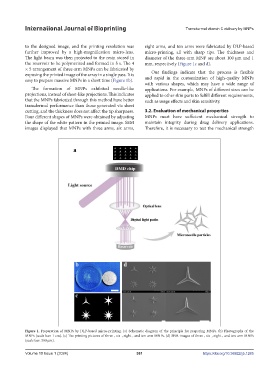Page 369 - IJB-10-1
P. 369
International Journal of Bioprinting Transdermal vitamin C delivery by MNPs
to the designed image, and the printing resolution was eight arms, and ten arms were fabricated by DLP-based
further improved by a high-magnification micro-lens. micro-printing, all with sharp tips. The thickness and
The light beam was then projected to the resin stored in diameter of the three-arm MNP are about 100 μm and 1
the reservoir to be polymerized and formed in 5 s. The 4 mm, respectively (Figure 1c and d).
× 5 arrangement of three-arm MNPs can be fabricated by
exposing the printed image of the array in a single pass. It is Our findings indicate that the process is flexible
easy to prepare massive MNPs in a short time (Figure 1b). and rapid in the customization of high-quality MNPs
with various shapes, which may have a wide range of
The formation of MNPs exhibited needle-like applications. For example, MNPs of different sizes can be
projections, instead of sheet-like projections. This indicates applied to other skin parts to fulfill different requirements,
that the MNPs fabricated through this method have better such as usage effects and skin sensitivity.
transdermal performance than those generated via sheet
cutting, and the thickness does not affect the tip sharpness. 3.2. Evaluation of mechanical properties
Four different shapes of MNPs were obtained by adjusting MNPs must have sufficient mechanical strength to
the shape of the white pattern in the printed image. SEM maintain integrity during drug delivery applications.
images displayed that MNPs with three arms, six arms, Therefore, it is necessary to test the mechanical strength
Figure 1. Preparation of MNPs by DLP-based micro-printing. (a) Schematic diagram of the principle for preparing MNPs. (b) Photographs of the
MNPs (scale bar: 1 cm). (c) The printing pictures of three-, six-, eight-, and ten-arm MNPs. (d) SEM images of three-, six-, eight-, and ten-arm MNPs
(scale bar: 300 μm).
Volume 10 Issue 1 (2024) 361 https://doi.org/10.36922/ijb.1285

